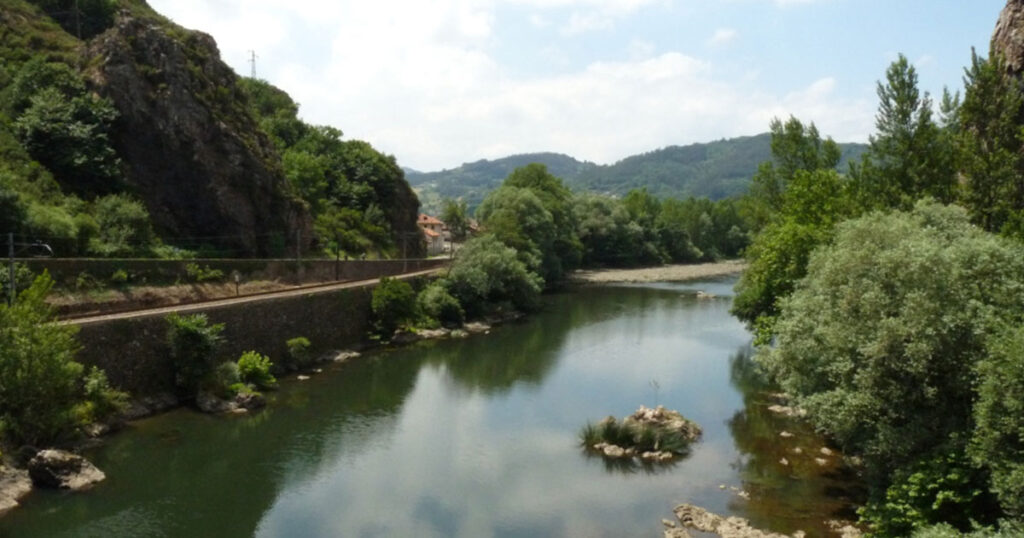
The Río Manzanares passes through Madrid on its way from its headwaters in the Sierra de Guadarrama to the end of its course, where after 92 kilometers it meets and merges into the Tajo. Francisco de Goya, who lived for five years on a farm on the banks of the Manzanares, depicts the river in some of his best-known paintings. Poets too make mention of it. But who tells the stories of the Río Nora, which passes by my town of Pola de Siero on its 62 kilometer course from its headwaters to where it joins the Nalón? No songs I know of, no stories or famous paintings commemorate life along its banks, though here, as in rivers all over the country, water was fetched, the washing was done, and in the shade of trees along its banks, people picnicked and bathed. Some must have paused too just to admire the vistas. Near its mouth, the Nora cuts back and forth in large loops and bends, called meanders in English and practically the same in Spanish, meandros. The meanders on the Nora are especially beautiful and are designated a national natural monument, protected since 2012.
Not protected and presumably not as remarkable are the bends in the Nora where it runs past La Pola, in the bottomland below the town. An asphalted river path winds beside the river. Five times in two kilometers, bridges span the water, and the path passes from one bank of the river to the opposite, as if to gain a better foothold on the far side. Rather than one following the other, the two paths seem intertwined, the path of the river and the man-made path beside it. One cold January morning, after two days of storms across Asturias, with rain near the coast, snow in the mountains, and hail mixed with sleet in La Pola, the rain ceased, and I left my house to walk down to the river to see what was happening.
The access road down from the town was streaming with water, practically a river itself, and the river beyond was swollen and muddy. When I reached the river path near the old Roman bridge, I was amazed to see that the river seemed on the point of overflowing its banks on both sides, swirling close to the river path on the near side and inundating a field on the far one.
I followed the river from the open meadows into a wooded stretch where trees grow so close to the water that they stick out from the steep banks and lean over the river, practically part of it. That day was different. The chocolate-colored water filled the narrow channel, sweeping along, bouncing off the banks where the river course curved, hurrying on, under the bridges, around the bends, past the trees stretching toward it with splayed, finger-like twigs.
The wet black trunks, the chocolate water, the bony grasping fingers. Despite the rushing river, there was a stillness to the day.
The rain was holding off but seemed likely to start again at any moment. Ahead, at a bend, the trees were even thicker. They clustered on the bank, and a few stood knee-deep in eddies just below. They gave the impression they were bracing not against the river’s push but against the call of something they might not resist: the tumbling water, the gray sky. One or two seemed to have waded halfway in. I looked up and then down the river. All around me, I could see the trees in congregation, some dipping their toes, some deep in the water, some watching. A whole arboreal landscape had come to life, and the community stood in the balance between the steadying tug of their roots as they leaned toward the water and the tug of the water itself. The trees along the bank were easing into the current, the trees on the hillside above the path shifting ever so slightly nearer. The river surged and rolled. Trees, I wondered, what do you feel? What do you hear in the voice of the river? Foolish questions on a cold, wet morning. But not one bit foolish the words of Victoria Chang in her poem “In a Clearing”: “My whole life, I thought to / mourn leaves falling. Now I / marvel at all the splitting.”
How marvelous to be among the trees at riverside on that wet cold morning, drops still falling from dark lifted branches, the scene splitting into its components of gray asphalt, wet bark, spindly bare branches, churning chocolatey water, and whole trees on the verge of parting to join the river.
Just a day later, when I returned, I saw toppled trees split and broken at the river’s edge. They lay as they had fallen, half in and half out of the water. Others had retreated from the verge. The river too had withdrawn and was again but another element of the unified picture of the landscape after a storm.

